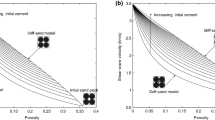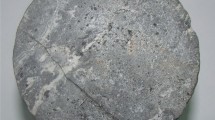Abstract
The aim of this paper is to improve estimation of shear-wave velocity in carbonate rocks. The region being studied is an oil field located in southwest Iran, where Upper Cretaceous carbonates act as the producing reservoir. These fracture bearing carbonates make the study of this reservoir complicated. Moreover, the accuracy and the precision of microstructure and pore type can affect the rock physics models by either directing or distracting these models from the typical models. The geological studies (thin sections, scanning electron microscope and core computer tomography scan) show that the reservoir mainly contains large pores with aspect ratios between 0.1 and 0.9. The existence of fractures is also demonstrated by a formation micro-imager and geological analyses. In this study, the applications of two rock physics models are investigated: (1) self-consistent approximation following the Gassmann equation and (2) Xu–Payne method, which has been carried out using the differential effective medium approach. In addition, for improving model predictions, these two rock physics models are fused by the ordered weighted averaging (OWA) aggregation operator that offers the most appropriate results. Furthermore, there are similarities between the three mentioned models based on the estimated values when compared to the measured dipole shear sonic imager log. Ultimately, the analysis and results demonstrate that the OWA model gives the best compatibility with the original well-log data. In other words, the reason why the OWA model provides the best results in the studied carbonates can be related to its optimization algorithm for defining model parameters.



















Similar content being viewed by others
References
Ahr, W. M. (2011). Geology of carbonate reservoirs: The identification, description and characterization of hydrocarbon reservoirs in carbonate rocks. Hoboken: Wiley.
Anemangely, M., Ramezanzadeh, A., & Tokhmechi, B. (2017). Shear wave travel time estimation from petrophysical logs using ANFIS-PSO algorithm: A case study from Ab-Teymour Oilfield. Journal of Natural Gas Science and Engineering,38, 373–387.
Asoodeh, M., & Bagheripour, P. (2012). Prediction of compressional, shear, and stoneley wave velocities from conventional well log data using a committee machine with intelligent systems. Rock Mechanics and Rock Engineering,45(1), 45–63.
Bagheripour, P., Gholami, A., Asoodeh, M., & Vaezzadeh-Asadi, M. (2015). Support vector regression based determination of shear wave velocity. Journal of Petroleum Science and Engineering,125, 95–99.
Berryman, J. G. (1995). Mixture theories for rock properties. Rock Physics and Phase Relations: A Handbook of Physical Constants,3, 205–228.
De Sousa, M. C., De Figueiredo, J. J., da Silva, C. B., & Nascimento, M. J. D. S. (2019). Prediction of S-wave velocity by a hybrid model based on the Greenberg-Castagna equation. Journal of Petroleum Science and Engineering,172, 303–313.
Du, Q., Yasin, Q., & Ismail, A. (2018). A comparative analysis of artificial neural network and rock physics for the estimation of shear wave velocity in a highly heterogeneous reservoir. In SEG technical program expanded abstracts 2018 (pp. 2246–2250). Society of Exploration Geophysicists.
Gholami, R., Moradzadeh, A., Rasouli, V., & Hanachi, J. (2014). Shear wave velocity prediction using seismic attributes and well log data. Acta Geophysica,62(4), 818–848.
Greenberg, M. L., & Castagna, J. P. (1992). Shear-wave velocity estimation in porous rocks: Theoretical formulation, preliminary verification and applications 1. Geophysical Prospecting,40(2), 195–209.
Hall, D. L., & Llinas, J. (2001). Handbook of multisensor data fusion. Boca Raton: CRC Press.
Mavko, G., Mukerji, T., & Dvorkin, J. (2009). The rock physics handbook: Tools for seismic analysis of porous media (2nd ed.). Cambridge: Cambridge University Press.
Mianabadi, H., Sheikhmohammady, M., Mostert, E., & Van de Giesen, N. (2014). Application of the ordered weighted averaging (OWA) method to the Caspian Sea conflict. Stochastic Environmental Research and Risk Assessment,28(6), 1359–1372.
Nelson, R. (2001). Geologic analysis of naturally fractured reservoirs (2nd ed.). Amsterdam: Elsevier.
Nourafkan, A., & Kadkhodaie-Ilkhchi, A. (2015). Shear wave velocity estimation from conventional well log data by using a hybrid ant colony–fuzzy inference system: A case study from Cheshmeh–Khosh oilfield. Journal of Petroleum Science and Engineering,127, 459–468.
Parvizi, S., Kharrat, R., Asef, M. R., Jahangiry, B., & Hashemi, A. (2015). Prediction of the shear wave velocity from compressional wave velocity for Gachsaran Formation. Acta Geophysica,63(5), 1231–1243.
Rajabi, M., Bohloli, B., & Ahangar, E. G. (2010). Intelligent approaches for prediction of compressional, shear and Stoneley wave velocities from conventional well log data: A case study from the Sarvak carbonate reservoir in the Abadan Plain (Southwestern Iran). Computers & Geosciences,36(5), 647–664.
Rezaee, M. R., Ilkhchi, A. K., & Barabadi, A. (2007). Prediction of shear wave velocity from petrophysical data utilizing intelligent systems: An example from a sandstone reservoir of Carnarvon Basin, Australia. Journal of Petroleum Science and Engineering,55(3–4), 201–212.
Ruiz, F., & Dvorkin, J. (2010). Predicting elasticity in non-clastic rocks with a differential effective medium model. Geophysics,75(1), E41–E53.
Seifi, H., Tokhmechi, B., & Moradzadeh, A. (2018). Evaluation of Kuster–Toksoz and Xu–Payne rock physics modeling in an Iranian carbonate hydrocarbon reservoir. Journal of Research on Applied Geophysics. http://jrag.shahroodut.ac.ir/article_1368.html.
Singh, S., & Kanli, A. I. (2016). Estimating shear wave velocities in oil fields: A neural network approach. Geosciences Journal,20(2), 221–228.
Tokhmechi, B., Memarian, H., Noubari, H. A., & Moshiri, B. (2009). A novel approach proposed for fractured zone detection using petrophysical logs. Journal of Geophysics and Engineering,6(4), 365.
Xu, S., & Payne, M. A. (2009). Modeling elastic properties in carbonate rocks. The Leading Edge,28(1), 66–74.
Yager, R. R. (1988). On ordered weighted averaging aggregation operators in multi criteria decision making. IEEE Transactions on systems, Man, and Cybernetics,18(1), 183–190.
Yager, R. R. (2002). On the cardinality index and attitudinal character of fuzzy measures. International Journal of General Systems,31(3), 303–329.
Yang, Y., Gao, G., Zhao, B., & Gui, Z. (2017). S-wave velocity estimation for calcium-bearing shaly sand formation. In International Geophysical Conference, Qingdao, China, 17–20 April 2017 (pp. 530–533). Society of Exploration Geophysicists and Chinese Petroleum Society.
Yang, Y., Ma, J., Wang, H., & Li, L. (2018). Shear wave velocity prediction with optimized Xu–White model constrained by varying aspect ratios in tight sandstone reservoir. In International geophysical conference, Beijing, China, 24–27 April 2018 (pp. 514–517). Society of Exploration Geophysicists and Chinese Petroleum Society.
Zhao, L., Nasser, M., & Han, D. H. (2013). Quantitative geophysical pore-type characterization and its geological implication in carbonate reservoirs. Geophysical Prospecting,61(4), 827–841.
Zhou, Q., Yin, X., Cao, D., Sun, W., & Wang, H. (2017). Shear wave velocity estimation based on the rock physics model with the multi-variables information constraint. In International geophysical conference, Qingdao, China, 17–20 April 2017 (pp. 1083–1086). Society of Exploration Geophysicists and Chinese Petroleum Society.
Author information
Authors and Affiliations
Corresponding author
Rights and permissions
About this article
Cite this article
Seifi, H., Tokhmechi, B. & Moradzadeh, A. Improved Estimation of Shear-Wave Velocity by Ordered Weighted Averaging of Rock Physics Models in a Carbonate Reservoir. Nat Resour Res 29, 2599–2617 (2020). https://doi.org/10.1007/s11053-019-09590-6
Received:
Accepted:
Published:
Issue Date:
DOI: https://doi.org/10.1007/s11053-019-09590-6




